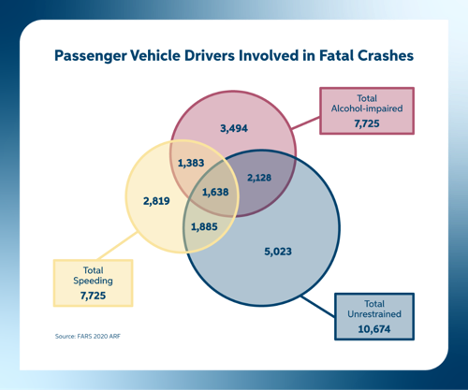Read time: 2 minutes
I know – I know! We’re all tired of talking about the PANDEMIC … It affected about every segment of our lives and continues to in many ways … However, 2020 brought about several changes to our driving habits.
With fewer drivers on the road, you’d think there would be fewer accidents and fatalities, but the opposite happened −in staggering amounts. Driving during the pandemic turned out to be riskier and even more dangerous than before 2020.
Here’s the four surprising ways that studies found driving habits changed in 2020 and 2021:
1. Motor vehicle accident fatalities increased while injuries decreased
Despite traveling less, the National Highway Traffic Safety Administration found that the fatalities related to accidents increased at a rate not seen since World War II. In 2020, 38,824 people were killed in traffic crashes in the U.S. This is about a 6.8% increase from 2019. The fatality rate per 100 million vehicle miles driven (VMT) increased 21%, which is the largest percentage increase on record.
Meanwhile, injuries in motor vehicle accidents decreased by about 17%. This sort of contrast continues with several of the other changes they observed.

2. Seat belt usage only decreased slightly
Fortunately, seat belt usage only slightly decreased from 90.7% in 2019 to 90.3% in 2020. However, being unrestrained still made accidents far more likely to be fatal because of all the other risky driving behaviors that increased significantly. Among passenger vehicle occupants killed in 2020, more than half (51%) were unrestrained.
3. Significant increase in alcohol-impaired-driving fatalities
Alcohol-impaired-driving fatalities increased by 14% from 2019 to 2020, which accounts for 30% of 2020 overall fatalities. Alcohol-impaired-driving fatality rate per 100 million VMT increased by 29% from 0.31 in 2019 to 0.40 in 2020.
Early in the pandemic, March and April of 2020, there was a decrease in alcohol-impaired-driving fatalities. However, after those first two months, fatalities from alcohol-impaired driving continually increased, with the highest increases being in the summer months of 2020.

4. Speeding at even higher speeds
Another huge contributor to the rise in fatalities in motor vehicle accidents in 2020 was speeding. Traffic data from the Office of Behavior Safety Research and Wagner showed average speeds increased during the last three quarters of 2020, and extreme speeds, those 20 mph (or more) higher than the posted speed limit, became more common. Analyses from their data on fatal crashes show an estimated 11% increase in speeding-related fatalities.
So, while there were fewer drivers on the roads, most risky driving behaviors increased both in frequency and often severity as well. These perplexing changes form the basis of several theories as to why drivers took more risks during 2020. But, no matter the reason, we encourage you to revisit safe driving habits to keep everybody safe on the roads!
Sources:
- National Highway Traffic Safety Administration (NHTSA)
- Wagner et al., 2020 and Office of Behavioral Safety Research traffic data
*Products referenced may not be approved/available in Tennessee. Limitations and conditions may apply. Premium will be based on benefits chosen and policy rates available at time of application.
Disclaimer: This article is not expert advice. The analysis of coverage is in general terms and is superseded in all respects by the Insuring Agreements, Endorsements, Exclusions, Terms and Conditions of the Policy. Some of the coverage mentioned in this material may not be applicable in all states or may have to be modified to conform to applicable state law. Some coverages may have been eliminated or modified since the publishing of this material. Discounts may not be available in all states. Limitations and conditions may apply. Premiums will be based on benefits chosen. Please check with us here at Benton White Insurance Auto-Owners Insurance Agent for details.”
Copyright Auto-Owners Insurance Company © 2023. All Rights Reserved.





